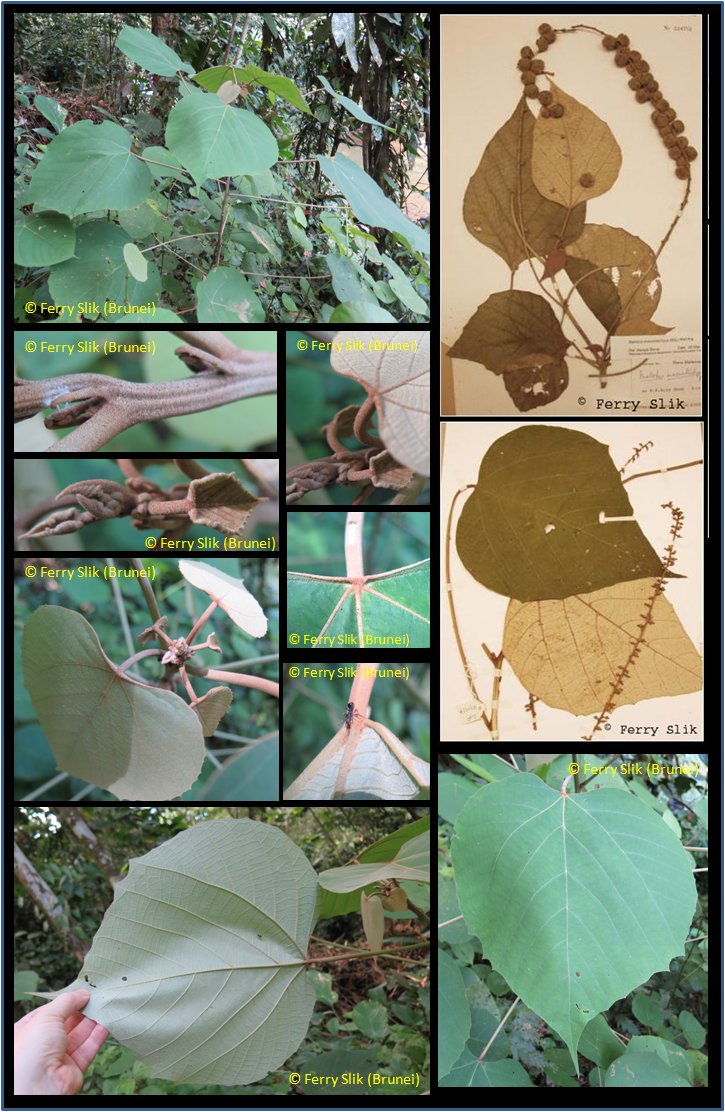Mallotus macrostachyus (Miq.) Mull.Arg., in DC. Prodr. 15, 2 (1866)
Latin for 'long spikes', referring to the inflorescences.Synonyms
Mallotus insignis Mull.Arg.
Rottlera macrostachya Miq.
Diagnostics
Understorey tree up to 16 m tall and 25 cm dbh. Stipules ca. 3(-7) mm long.
Leaves alternate, simple, tripli-veined, densely hairy below, hairy domatia in
secondary vein axils, with two basal nectary glands at upper surface, leaf
margin at petiole insertion usually curved upwards. Flowers ca. 4 mm diameter,
green-yellowish, placed in long panicles. Fruits ca. 13 mm diameter,
yellow-brownish, roundish, dehiscent, densely hairy capsules, seeds with black
aril.
Description
Shrubs to small trees up to 16 m high, dbh up to 25 cm, dioecious, occasionally monoecious;
crown spreading, flat. Outer bark finely fissured, soft, brownish grey, inner bark fibrous
inwards, yellowish green, cambium yellow, sapwood white. Indumentum tomentose to puberulent.
Stipules triangular, 2.8-7 by 1-1.8 mm, persistent, margin entire, apex acute. Leaves alternate
to apically subopposite; petiole 2-36 by 1-4 mm; blade subpeltate for 1.5 mm, peltation near
petiole insertion often thick and frequently curved upwards, broadly ovate to ovate, 9.2-31 by
7.8-25 cm, length/width ratio 1-1.3, base truncate, rounded, to slightly cuneate, margin dentate,
or serrate, rarely shallowly 2-lobed at widest part of blade, upper surface dark green, basally
with 0-2 extrafloral nectaries, 1.3-3 by 0.5-2.5 mm, marginal nectaries 0-9 per side, 1.5-10 mm
from margin, 0.6-1 by 0.6-8 mm, lower surface brownish grey, domatia with a dense tuft of woolly
hairs, 3-nerved, nerves 7 or 8 per side, mostly ending in the margin. Inflorescences axillary
or terminal, unisexual or bisexual, axes light brownish, basally 2-4 mm thick; bracts triangular,
1-2.5 by 0.6-10 mm, persistent, margin entire, bracteoles absent. Staminate inflorescences up
to 112 cm long, side branches up to 65 cm long, with 1 or 2 flowers per node, nodes per branch
up to 120. Staminate flowers 4-4.5 mm diam., fragrant; pedicels 3.2-4.2 mm long; sepals 3 or 4,
2-2.7 by 1.2-1.7 mm; stamens 60-90, filaments 1-3 mm long, white, anthers 0.3-0.35 by 0.2-0.25 mm,
light yellow; pistillode present. Pistillate inflorescences spikes, up to 80 cm long, seldomly
with side branches (up to 14 cm long), nodes up to 150. Pistillate flowers 3-7 mm diam., sessile;
calyx 4- or 5-lobed, connate almost to the apex, 3-5 mm long, lobes 0.5-1.7 by 0.8-1.5 mm, light
brownish; ovary 3-locular, 3.2-4 by 1.8-2.2 mm, spines individually not visible, style up to
1.2 mm long; stigmas 4-5 mm long, dark brown; staminodes absent. Fruits 11-16 by 10-14 mm, light
green with brown tomentum, spines numerous, straight, thin, less hairy, up to 4 mm long, hairs
forming a continuous layer, rubbing off; column 5-6 by 1.2-2 mm. Seeds ellipsoid, 4-5 by 4-4.5
by 3.5-4 mm, surface irregular, dark brown; hilum 2.3-2.5 by 1.8-2 mm. [from Flora Malesiana]
Ecology
Mostly in disturbed sites in mixed dipterocarp and keranga forests up to 800
m altitude. Common along roadsides, forest edges, riversides, large gaps,
hillsides and ridges. On sandy to clay soils.
Uses
Firewood. The leaves are used as an antidote against snake poison.
Distribution
Peninsular Thailand, Peninsular Malaysia, Sumatra, Borneo.
Local names
Borneo: Balik angin, Entupak, Kayu balik angin, Kelempah pinggai, Kelipak pinggai.
Brunei: Lekon abai, Lokon (Dusun); Entupak, Nentupak (Iban).
Indonesia (Borneo): Kapit mawat (Kenyah), Kayu balikangin, Kayu kapit, Buah beliangin,
Kajoe si tarak balanggingan.
Malay Peninsula: Selau, Balek angin.
Sabah: Dahau (Kadazan Kinabatangan); Dahu (Dusun/Bundu Tuhan); Dauah (Dusun Putatan); Mangabong,
Ngoludon, Padauh-padau, Pedau-pedau (Dusun); Tondon tondon (Suluk).
Sarawak: Balek angin; Entupak, Kelempah pinggai, Kelipak pinggai, Kerimpah pinggai (Iban).
Sumatra: Baliek anggien, Batang balik; Si tarak balanggingan.
